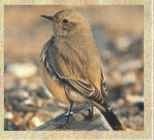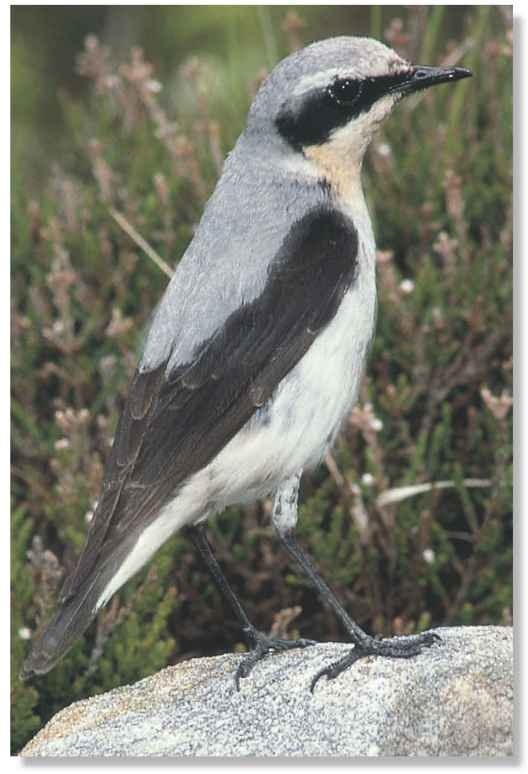ORDER
Passeriformes
FAMILY
Turdidae
GENUS & SPECIES
KEY FEATURES
• A ground-loving bird of moorland, alpine and open rocky areas, it sings from vantage points while remaining alert for food and predators
• Male performs a feather-fluffing, dancing display when intruders invade its territory
• Migrates long distances between breeding grounds and wintering areas
WHERE IN THE WORLD?
Breeds from Alaska, 1 Canada and Greenland to Europe, the Middle East and northern Asia, including most of Siberia; all but a small population in Iraq overwinter in sub-Saharan Africa
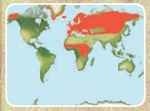
LIFECYCLE
One of the first migratory birds to appear at its breeding grounds, the northern wheatear brings life, color and sound to bleak hills and alpine areas emerging from a long winter.
HABITAT
The northern wheatear breeds in temperate and subarctic regions. Almost all of these birds winter in hot, dry areas of tropical Africa. During the breeding season, it is often found on rocky slopes, scree and alpine meadows at altitudes of up to 10,000′.
Avoiding forests and woodlands, the wheatear prefers open country, and typically breeds in exposed areas rich in insect life, such as hillsides, stony slopes and walled fields where it finds plenty of nesting sites and vantage points.The wheatear is also at home on rocky coasts, bogs and Arctic tundra.
In its winter quarters in sub-Saharan Africa, the wheatear remains a lover of open ground, inhabiting short-grass savannah, farmland, barren rocky hills and plains recently cleared by fire.
FOOD & FEEDING
The wheatear feeds mainly on insects, such as beetles, flies and other invertebrates, including snails, slugs and spiders. The bird pounds large insects, such as grasshoppers, against the ground to break off inedible legs and wings. In autumn, when food becomes scarce, the wheatear supplements its diet with berries.
The bird uses two hunting strategies to locate and capture prey. Commonly, it perches on a low rock or bush, watching for any movement on the ground. It then darts down, sometimes hovering above its quarry, before pouncing.
The second method involves hopping over open ground before pausing and watching for prey. If nothing stirs, the bird repeats the process until successful.
Insect addict While eating, the wheat-ear looks for more.
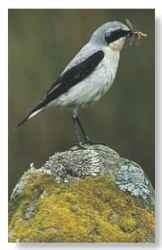
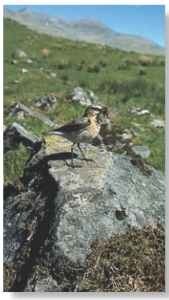
A Windswept isolation Breeding birds favor remote, open regions.
Nearly the entire population of wheatears winters south of the Sahara.
During migrations, wheatears often cross vast tracts of ocean. Birds from Greenland may take over 30 hours to make the 1,450-mile crossing to Africa.
The wheatear’s name comes from the Anglo-Saxon words hwit and oers, which mean “white” and “rump.”
HILLSIDE HUNTER
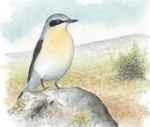
A fine view…
Perched on a rock, a wheatear scans the bare ground below for signs of prey. Its sharp eyesight can detect the smallest of movements.
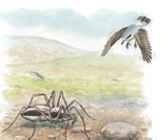
A false move…
As a large wolf spider emerges from hiding, the wheatear swoops down instantly for a closer look.
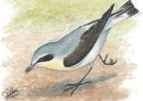
Unequal race…
The spider scuttles for cover, but the bird easily outpaces it and catches it in its slim bill. Large prey offers a highly nutritious snack.
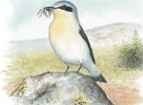
Dining at leisure
The bird carries its spoils back to its vantage point. Here, it can safely eat while keeping a close watch for predators.
BREEDING
Living in open areas devoid of trees, the northern wheatear must build its nest in crevices in stone walls, rocky ground or in abandoned burrows in order to conceal it from predators, such as weasels and rats.
The nest foundation is an untidy mass of dried stems, rootlets and grass, occasionally decorated with a large feather This holds a cup-shaped nest constructed of tightly woven grass stems, leaves, moss and lichen.
The pale blue eggs are incubated mainly by the female. Both parents feed the hatchlings, which grow swiftly. After fledging it is important that the young birds put on weight quickly, building themselves up for the long migration south.
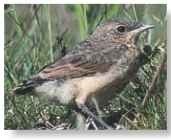
A Safety coloring Brown spotted plumage helps hide the fledgling.
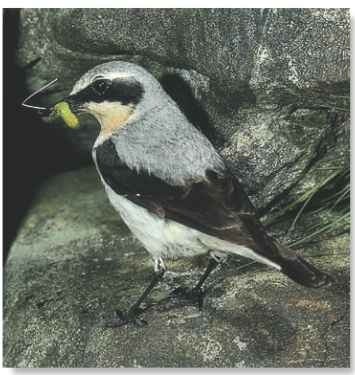
Feeding the family Parent birds must hunt continually to feed young.
BEHAVIOR
Being a mostly solitary bird of open country, the northern wheatear is shy and wary — constantly alert to the threat of attack by birds of prey, such as falcons. When alarmed, it flies swiftly for cover uttering a harsh, penetrating chack-chack call to warn its mate of the danger.
The wheatear is territorial and returns to the same breeding site each year. If both partners survive the arduous migration, they are likely to pair up once again. Should only one partner survive, he or she waits for a new mate to arrive.
The male defends his territory from intruders with a vigorous, warbling call accompanied by a dancing display. With fluttering wings he leaps rapidly and erratically from side to side, ruffling his breast feathers and flicking his tail. He may even fly over his rival — appearing as a swirling mass of feathers. The rival may attempt to outdo the territory owner with an energetic and vocal display of his own.
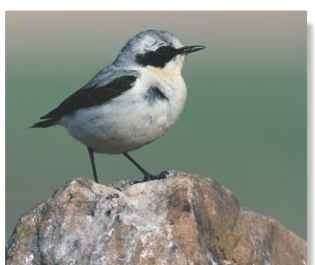
A On the stage
The male sings from a vantage point.
CONSERVATION
The northern wheatear remains common in its range, but populations in Europe have declined in recent years. This is partly due to the increased use of pesticides, leaving little food for the bird during its breeding season. Forestation of upland areas also reduces the bird’s favorite habitats. Like most migrants, many wheatears are targeted by “sport” hunters — particularly in Mediterranean countries — who shoot down songbirds and birds of prey as well as gamebirds.
PROFILE
Northern Wheatear
Jaunty and restless, the wheatear flits, hops or runs from perch to perch, flicking its wings and flaunting its strongly marked tail if threatened.
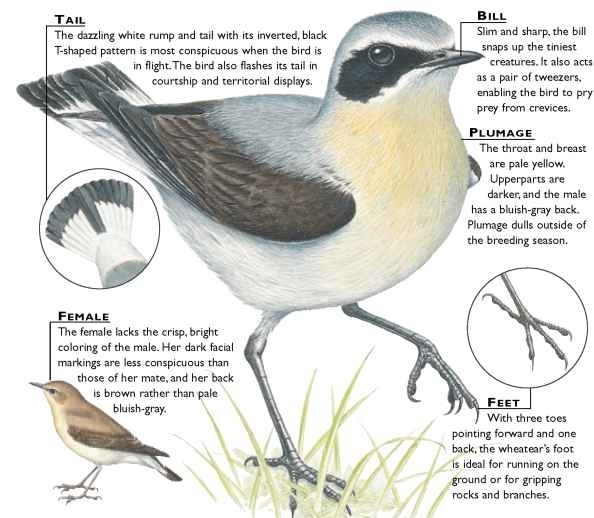
CREATURE COMPARISONS
Whereas the northern wheatear is a bird of open country, the green cochoa (Cochoa viridis), a closely related member of thrush family, inhabits mountain forests. Found at altitudes of 10,000-16,500′ in the Himalayas and other mountains of-southeastern Asia, the green cochoa hunts in deep undergrowth for insects. It forages in a similar manner to the wheatear, but its more powerful bill enables it to tackle larger prey.The green cochoa’s nest is more refined than that of the wheatear, constructed within tree foliage from mosses, leaves and plant fibers. A far larger bird than the wheatear the male green cochoa’s head is bluish-violet, while his wings and tail vary from gray to powder-blue.
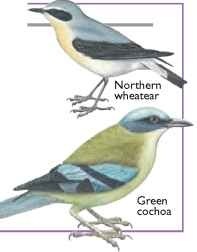
| VITAL Weight |
STATISTICS 0.5-1 oz. |
| Length | 6″ |
| Wingspan | 10-12″ |
| Sexual Maturity | 1 year |
| Breeding Season | April-July 1 |
| Number of Eggs | 5-6 |
| Incubation Period | 13 days |
| Fledging Period | 15 days |
| Breeding Interval | 1 or 2 broods a year |
| Typical Diet | Mainly insects; also spiders, mollusks, centipedes, woodlice; some berries |
| Lifespan | Up to 7 years |
RELATED SPECIES
• The wheatear belongs to the genus Oenanthe, which also contains the desert wheatear, O. deserti (below). The genus is part of the family Turdidae, which is one of the largest families in the order Passeriformes.
